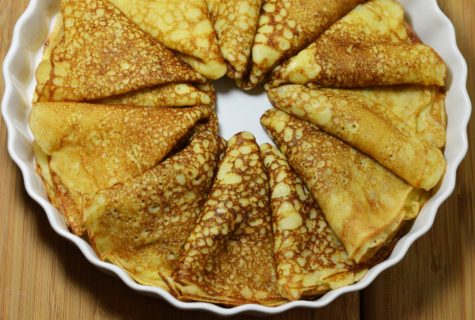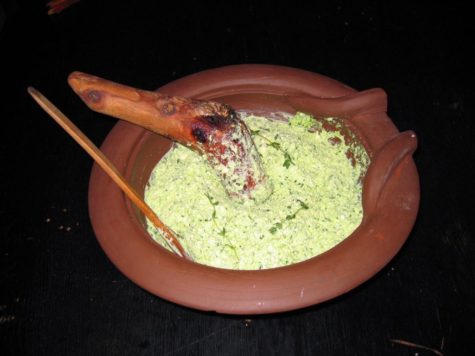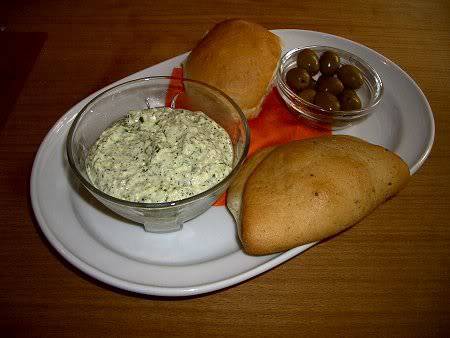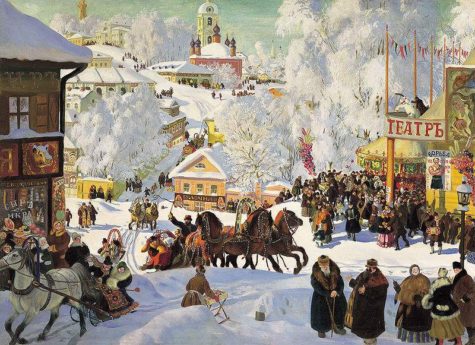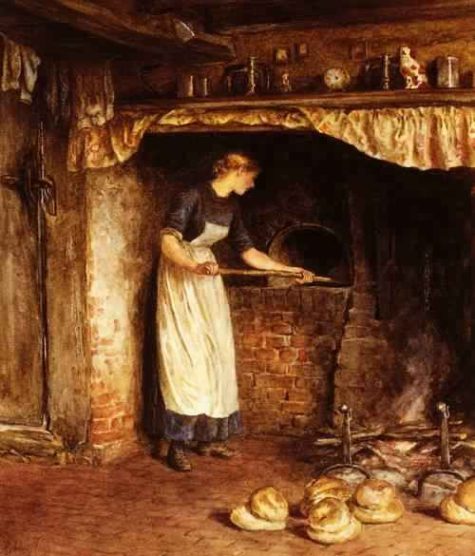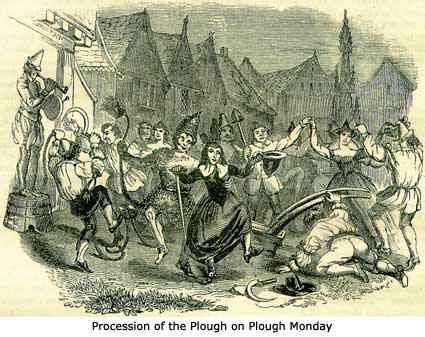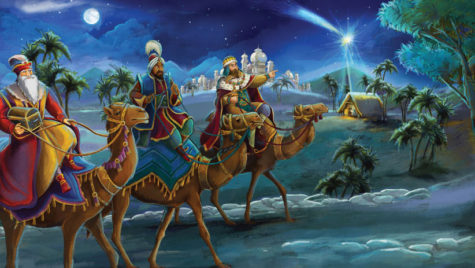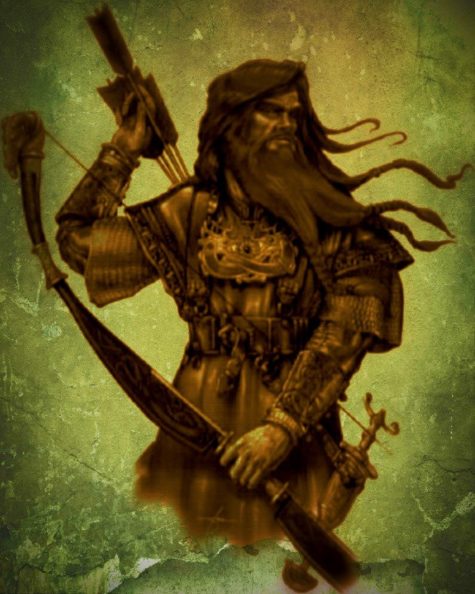Eating Together
Blins or blini were symbolically considered by early Slavic peoples in pre-Christian times as a symbol of the sun, due to their round form. They were traditionally prepared at the end of winter to honor the rebirth of the new sun. This tradition was adopted by the Orthodox church (Shrovetide, Butter Week, or Maslenitsa) and is carried on to the present day. Blini were also served at wakes to commemorate the recently deceased.
Traditional Russian blini are made with yeasted batter, which is left to rise and then diluted with cold or boiling water or milk. When diluted with boiling water, they are referred to as zavarniye blini. The blini are then baked in a traditional Russian oven. The process of cooking blini is still referred to as baking in Russian, even though these days they are almost universally pan-fried, like pancakes.
French crêpes made from unyeasted batter (usually made of flour, milk, and eggs) are also not uncommon in Russia, where they are called blinchiki and are considered to be an imported dish. All kinds of flour may be used for making blini: from wheat and buckwheat to oatmeal and millet, although wheat is currently the most popular.
What follows is a recipe for traditional Russian blini from RusCuisine. These pancakes are served with different dressings – most popular are sour cream, jam, syrup, red caviar, salmon, cottage cheese and others.
Ingredients:
- 3 1/2 c All-purpose flour
- 3 tb Water warm 105-F degrees
- 1 1/2 pk Yeast dry
- 3 3/4 c Milk warm 105-F degrees
- 1 tb Sugar
- 1/2 c Heavy cream
- 1 Egg white
- 2 Egg yolks
- 1 ts Salt
- 4 tb Butter unsalted melted and cooled until just warm
Take 1 tablespoon of the flour, the warm water, 1 teaspoon of the sugar, and the yeast and mix together in a small bowl. Cover and set in a warm place for 15 minutes. Mix in a large bowl the the 1 1/2 teaspoons of sugar, flour, milk, the yeast mixture and salt. Beat by hand for 4 minutes. Cover and set in a warm place for 1 hour.
Mix the egg yolks and remaining sugar and add to the natter along with the butter and beat with an electric mixer for 3 minutes or by hand for 8 minutes. Whip the egg white separately and whip the cream as well until very stiff. Fold in the cream then the egg white making sure to mix well. Cover again and place in a warm place for 45 minutes.
Grease the skillet with butter, place 2 tablespoons of batter in the center of the skillet, (at this point you may add any of the flavor garnishes that you wish or none at all) cook for 1 minute, turn the bliny over, and cook for 35 seconds, and serve smothered in sweet butter.
Our recipe this week is straight out of the pages of Roman literature. Moretum is a delicious spread similar to our pesto—and the Roman poet Virgil was apparently a big fan!
The word “moretum” is Latin and is usually translated as “salad,” but that’s not really an accurate translation. It’s not a salad at all, at least not what we think of as salad in modern times. It’s a sort of spread or dip. Virgil is most often credited with the recipe. In his poem entitled “Moretum” he tells the story of Symilus, a peasant farmer, who is making his morning meal. He first makes the bread, but quickly realizes he has no meat to go along with the crusty creation. Concerned that man cannot survive on bread alone, he decides to make an accompaniment for his baked good. Virgil then describes the process by which Symilus makes his moretum. Both the bread and moretum-making are described in detail in the poem, but here is a little summary of the important moretum highlights, courtesy of Pass the Garum blog:
- Symilus gathers four heads of garlic (!), celery, parsley, rue, and coriander seeds.
- He grinds the garlic in his mortar and pestle, and adds salt and cheese.
- He then adds the celery, rue, parsley, and coriander seeds. The smell is so strong that it makes his eyes water!
- He adds some olive oil, finishes off the mixture, and slaps some on his freshly baked bread.
There are a couple of things about this recipe we will not be replicating in the recipe below. For one thing, there is an awful lot of garlic. We’re going to tone that down a bit, but feel free to pile it on if you’re a garlic fan. The Romans loved garlic. They believed it increased “strength and endurance” and so it was fed to “soldiers and sailors.”
It was also believed to “clean the arteries” and guard against toxins and infections. Today we know that garlic is often effective in treating and preventing many different ailments including, but not limited to, blood and heart conditions, some types of cancer, diabetes and even the common cold and flu.
More important than the potential overuse of garlic, rue is poisonous. However, rue is not altogether bad. In fact, it contains alkaloids that made it a useful treatment for indigestion during this time period (1st century BCE). But it also strongly influences the female menstrual cycle so pregnant women should definitely not consume it. We chose a recipe that leaves it out altogether.
Now that we’ve explored some history and cut out the dangerous ingredients, it’s time for a pesto party! Bake (or buy) a loaf of delicious bread to eat with your moretum and have some friends over for a night of Roman cuisine.
Roman Garlic Pesto (Moretum)
Ingredients
- 1 clove of garlic
- 1/2 of a celery stick (with its leaves)
- A small bunch of flat-leaf parsley
- 1 tablespoon of coriander seeds
- A pinch of salt
- Some aged pecorino cheese (approx. 8 ounces), feta is also a popular option
- 1 teaspoon of extra virgin olive oil
- A splash of vinegar
Instructions
Peel the garlic, add to the mortar and grind.
Add the salt, the cheese and the celery to the mortar and mash them up too. Really make sure to mix them well with the garlic from earlier.
To this paste, add the coriander seeds, parsley, oil and vinegar. I find that it is helpful to add the parsley in batches and break it down bit by bit rather than trying to do it all at once and making a mess. Test for flavor – if it is too garlicky, add more parsley.
Grab some bread and dip or spread ‘til your heart’s content!
From: Antiquity Now
According to archeological evidence from 2nd century A.D. Maslenitsa may be the oldest surviving Slavic holiday. Maslenitsa has its origins in the pagan tradition. In Slavic mythology, Maslenitsa is a sun-festival, personified by the ancient god Volos, and a celebration of the imminent end of the winter. In the Christian tradition, Maslenitsa is the last week before the onset of Great Lent.
During the week of Maslenitsa, meat is already forbidden to Orthodox Christians, and it is the last week during which eggs, milk, cheese and other dairy products are permitted, leading to its name of “Cheese-fare week” or “Crepe week”. The most characteristic food of Maslenitsa is bliny thin pancakes or crepes, made from the rich foods still allowed by the Orthodox tradition that week: butter, eggs and milk. Here’s a recipe: Classic Krasnye Blini
Since Lent excludes parties, secular music, dancing and other distractions from spiritual life, Maslenitsa represents the last chance to take part in social activities that are not appropriate during the more prayerful, sober and introspective Lenten season.
In some regions, each day of Maslenitsa had its traditional activity:
Monday:
Monday may be the welcoming of “Lady Maslenitsa”. The community builds the Maslenitsa effigy out of straw (из соломы), decorated with pieces of rags, and fixed to a pole formerly known as Kostroma. It is paraded around and the first pancakes may be made and offered to the poor.
Tuesday:
On Tuesday, young men might search for a fiancée to marry after lent.
Wednesday:
On Wednesday sons-in-law may visit their mother-in-law who has prepared pancakes and invited other guests for a party.
Thursday:
Thursday may be devoted to outdoor activities. People may take off work and spend the day sledding, ice skating, snowball fights and with sleigh rides.
Friday:
On Friday sons-in-law may invite their mothers-in-law for dinner.
Saturday: Saturday may be a gathering of a young wife with her sisters-in-law to work on a good relationship.
Sunday:
Relatives and friends ask each other for forgiveness and might offer them small presents. As the culmination of the celebration people gather to “strip Lady Maslenitsa of her finery” and burn her in a bonfire. Left-over pancakes may also be thrown into the fire and Lady Maslenitsa’s ashes are buried in the snow to “fertilize the crops”.
Found at: Wikipedia
Maslyanitsa means butter in Russian, and it is also the name of the festival that says goodbye to winter and welcomes summer. From Moscow to St. Petersberg, Russians celebrate Butter Week just before their Lent fast days. The dates vary falling sometime in February or March. (In 2018, this festival begins on Feb 12).
During Lent, meat, fish, dairy products and eggs are forbidden. Furthermore, Lent also excludes parties, secular music, dancing and other distractions from the spiritual life. Thus, Maslenitsa represents the last chance to partake of dairy products and those social activities that are not appropriate during the more prayerful, sober and introspective Lenten season.
Monday is the high point of celebration, when people cook pancakes, or blini, served with honey, caviar, fresh cream and butter. The more butter there is, the hotter the sun is expected to be in the coming summer.
The most characteristic food of Maslenitsa is bliny (pancakes). Round and golden, they are made from the rich foods still allowed by the Orthodox tradition: butter, eggs and milk. Here’s an authentic traditional recipe: Classic Krasnye Blini.
Maslenitsa activities also include snowball fights, sledding, riding on swings and plenty of sleigh rides. In some regions, each day of Maslenitsa had its traditional activity: one day for sleigh-riding, another for the sons-in-law to visit their parents-in-law, another day for visiting the godparents, etc. The mascot of the celebration is usually a brightly dressed straw effigy of Lady Shrovetide, formerly known as Kostroma.
As the culmination of the celebration, on Sunday evening, Lady Maslenitsa is stripped of her finery and put to the flames of a bonfire. Any remaining blintzes (pancakes) are also thrown on the fire and Lady Maslenitsa’s ashes are buried in the snow “fertilize the crops”.
The last day of Butter Week is called “Forgiveness Sunday,” At Vespers on Sunday evening, all the people make a poklon (prostration) before one another and ask forgiveness, and thus Great Lent begins in the spirit of reconciliation and Christian love. The day following Forgiveness Sunday is called Clean Monday, because everyone has confessed their sins, asked forgiveness, and begun Great Lent with a clean slate.
Found at: Wikipedia
The Fornacalia, a festival in honor of Fornax, the goddess of furnaces, was held in order that bread might be properly baked, and to bless the ovens used to dry grain. This festival was movable, and could have been held any time between Febuary 5th to February 17th.
Each year the Curio Maximus (a citizen charged with ensuring the observance of curial religious feasts) would announce the date of the Fornacalia and post a separate notice for each curia (neighborhood) in the Forum, probably indicating where each curia should gather for the final part of the celebration.
It is believed that every family in the curia brought far, that is, spelt (a kind of grain), to be toasted in the meeting hall and sacrificed to ensure that bread in the household ovens wouldn’t be burnt in the coming year. Then the curiae assembled for a collective feast.
If on the last day of the Fornacalia (17th of February) anyone had missed the feast or was not a member of a curia (or had forgotten which one he belonged to), he could make a private sacrifice at the general assembly of all the curiae called the Quirinalia. It is believed by some, that because of this the Romans called the Quirinalia the Stultorum feriae, the ‘Feast of Fools.’
To Do Today:
The Fornacalia was a festival of ovens, in which Fornax was invoked by baking wheat breads and other grain-related foods. So think about dusting off your cookbooks, especially any recipes from your family, and start baking! Even people pressed for time can usually make a bath of bread from frozen dough.
If you only own a microwave, have no fear – microwaveable soft-dough pretzels are readily available in the freezer section of your supermarket. Or, simpler still, have toast for breakfast this morning to internalize Fornax’s warm emotions. On the other hand, if you’d like to give Fornax a much needed break from her toils at your place, go out and eat! Just make sure to have some bread as part of your meal to welcome Fornax to your feast.
Finally, take any dried bread you have and crumble it up for the birds. Focus on your desire for love and closeness in your life. The birds will convey your wishes to Fornax, the heavens, and the four corners of creation.
A Ritual For Today
- Color: Brown
- Element: Fire
- Offerings: Give some of the loaves of bread to those who have need of it.
- Daily Meal: Everything baked – breads, cakes, pies, casseroles.
This ritual should be performed in the kitchen, with the altar built on top of the stove or inside the oven. Set a brown cloth with a red candle and many loaves of bread on wooden trays.
Invocation to Fornax
Goddess of the Oven
Lady of Fire Enclosed,
Sacred Baker of our food,
We all started as dough,
Raw and soft and unformed,
And we were patted into shape
By those who raised us,
Yet we could not bring ourselves
Fully grown to the table
Until we had endured
The hardening flame.
Be kind to us, Lady!
As we go through life
Let us not be scorched
Or spared the fire
But bring us gently through
To be our final selves.
Chant:
Baker of the Loaf of Earth
We endure your fire
(One of the loaves is broken and handed around and shared, some more are set aside to eat later, and then the rest are taken to some deserving place and donated.)
- Ritual from: Pagan Book of Hours.org
- Other information collected from various sources
The last day of each of the lunar months is the sacred day of the triple goddess of crossroads and the patroness of Witches, Hekate.
Hekate had many names and titles: Hecate Trevia, “of the three ways”; Hecate Phosphoros, “the light bringer”; Hecate Nykterian “of the night”; and Hecate Basileia, “Hecate Queen.” On this night of the waning Moon we have a perfect opportunity to work with this goddess and ask for her blessing to illuminate our darkest times, and grant us her protection.
Hecate, goddess of the crossroads, hear my cry,
Protect and guard me under your midnight sky.
Hecate Phosphoros “she who brings the light,”
Hecate Trevia bless me with your wisdom tonight.
Hekate’s ancient devotees held dinners in her honor, known as Hekate Suppers. Once upon a time, these dinners were consumed outside under the dark moon, ideally at a crossroads. One plate was reserved for Hekate; after her devotees dined, just before they departed, Hekate’s plate was laid down at the crossroads.
Foods associated with her were prepared. The entree was usually fish, especially red mullet. Devotees feasted and celebrated. Offerings and leftovers were placed outside the door or at a crossroads for Hekate and her hounds.
Even way back when, cynics scoffed that food placed outside was actually consumed by feral dogs and homeless people without realizing that this is Hekate’s intent: this is one way she accepts offerings. (The Church was still trying to eradicate this ritual as late as the eleventh century.)
A typical Hekate Supper menu includes eggs, fish roe, goat and sheep cheese, sprats, red mullet – a scavenger fish that was the subject of many taboos – garlic, mushrooms, and honey cake surrounded by blazing torches or cakes decorated with miniature imitation torches (candles). Other ideas include garlic, salmon, honey, and edible flowers.
Traditionally whatever is given to Hekate cannot be reclaimed. Thus, do not break out your priceless set of china; lay the meal on the ground or use a serving dish that will be incorporated into the offering. Once the offering is laid down, depart without looking back. Hekate determines who picks up the offering.
Smaller, private offerings may be left at a crossroads, too:
- Place offerings on a plate or flat stone and leave them at a crossroads after dark.
- Make your invocation and then walk away without looking back.
- Do not return for the plate, or any part of the offering, but consider it part of your gift.
Offerings can include the following:
- Eggs
- Garlic and honey (especially lavender honey)
- Croissants and crescent shaped breads and pastries
- Candles
- Incense
- Images of dogs, especially black dogs
- Actions on behalf of dogs
Encountering or hearing a dog is an indication that your petition has been heard.
Other nights sacred to Hekate:
- Friday the 13th – particularly if it falls in the month of August.
- November 16th is Hekate Night
- August 13th, in Italy, a festival is shared between Diana and Hekate
Sources:
- Invocation by Ellen Dugan
- The Powers That Be
In Belgium, the Monday after Epiphany is called “lost Monday” and is a day of universal idleness. Hence probably has arisen the custom, not confined, however, to Belgian workmen alone, of idling every Monday or as they call it “making blue Monday.”
Plough-Monday is the first Monday after Twelfth Day (6th of January), so the date varies from year to year. It is so called because, the Christmas holidays being over, the men return to their plough or daily work. It was customary on this day for farm laborers to draw a plough—called “white” on account of the mummers being dressed in white, gaudily trimmed with flowers and ribbons—through the parish, soliciting “plough-money,” which would be spent in a frolic. The queen of the feast was called Bessy. The plough was also called “fond” or “fool,” because the procession is fond or foolish, not serious nor of a business character.
Dressed in clean white smocks decorated with ribbons, the men dragged a plow (plough) through the village and collected money for the “plow light” that was kept burning in the church all year. Often men from several farms joined together to pull the plow through all their villages. They sang and danced their way from village to village to the accompaniment of music. In the evening, each farmer provided a Plough Monday supper for his workers, with plentiful beef and ale for all.
Some accounts depict something far more like Hallowe’en or carnival—men going door to door in outlandish disguise, singing and demanding a gift, and if they were given nothing, ploughing up the front garden. It seems likely that the original rite, like many such door-to-door seasonal processions, had both aspects—the plough was processed because it brought blessings, but ribaldry attended the celebrations and lack of respect for the plough and its attendants brought retribution. I assume the plough was blessed first, before being taken around.
Found in: Encyclopaedia of Superstitions and Almanac.com
Santa Claus may have gone back to the North Pole to rest, but it doesn’t mean the gift-giving (and receiving) is over — at least not for the thousands of children in Latin America and Spain anxiously awaiting“El Día de los Reyes” Celebration on Jan. 6th.
- Children leave their shoes right outside their doors so the Three Kings will leave their gifts inside, the bigger presents are placed around them.
- Many families leave a box of grass (or hay) and water for The Three King’s camels to eat. Similar to the tradition of leaving out cookies and milk for Santa Claus. Camels are known for being a bit sloppy and leaving a trail of hay behind that children can often follow to their gifts!
- Hispanic families will usually celebrate Three Kings Day with a scrumptious dinner that is topped off with the King’s Bread (Rosca de Reyes) for dessert. Children also sometimes make crowns to wear at the table in honor of the kings.
For many Christians, the holiday season doesn’t officially end until the 12th day of Christmas known as the “Feast of the Epiphany” or “Three Kings’ Day”.
The holiday marks the biblical adoration of baby Jesus by the three Kings, also referred to as three Wise Men or Magi. According to the Gospel of Matthew, the men found the divine child by following a star across the desert for twelve days to Bethlehem. Melchior, Caspar, and Balthazar — representing Europe, Arabia, and Africa respectively — traveled by horse, camel, and elephant in order to present baby Jesus with three symbolic gifts.
- Gold
- Frankincense
- Myrrh
The gold offered by one of the wise men is a symbolic acknowledgment of Jesus’ royal standing as “King of the Jews,” while the frankincense manifests the divine nature of the baby’s existence, since he is not an earthly king but the Son of God. And finally the myrrh, often used to embalm corpses, was gifted to the newborn as a symbol of Jesus’ mortality — foreshadowing his death as a means to cleanse humanity of its sins.
Reyes festivities come in different shapes and sizes across the globe from community parades to three-day celebrations at Disneyland. In Mexico, thousands gather every year to taste a mile-long “Rosca de Reyes” (Kings’ Bread) while others simply make the holiday staple at home honoring the tradition to hide a baby Jesus figurine within the bread — the person whose slice has the figurine must prepare tamales for everyone on the Day of the Candles on Feb. 2!
Source: Huffington Post
The Feast of Ullr was traditionally a hunting festival. Ullr, god of hunting, and the bow was honoured and a feast was shared by the tribe of the spoils of the hunt. I remember hearing somewhere about Skathi also being honoured on this day but I can’t recall where… Anyway, in addition to being the goddess of skiing, she also governs hunting and bows.
The tribe (or family) on this day would take a portion of the meat from the hunt and have a large and joyous feast before the winter sets in hard. Today, most of us do not hunt, we get our meals from the super market, and if we are lucky, we grow a small amount of herbs and vegetables for eating. But we always get our meat from the grocery store. So celebrating a feast of the hunt is not as powerful a gesture in out modern times.
Many Asatruar in the USA use the national Thanksgiving holiday to honor our Gods and Goddesses of the hunt (it is deer hunting season in many parts of the country). We thank them for a successful hunting season with a blot and also bless/honor those who hunt to support the family. Weapons are dedicated on this day to Ullr. Some also take advantage of the family-oriented secular holiday to honor their personal ancestors.
One way to do this is to set an extra place at the table and leave it empty so that any ancestor who wishes may join us for the feast. This is a great time for telling tales handed down through the family. Still other Asatruar refer to this holiday as “Weyland Smith’s Day” and use it to honor that great Germanic craftsman as well as those artists and artisans around us.
On this day also, you may want to take time out with family and friends to shoot bows, throw some axes, play some Kubb and always playing a little Glima (Scandinavian Folk Wrestling of which Ullr is still remembered as the god of).
Collected from various sources including Jake Jackson and Pagan Space
